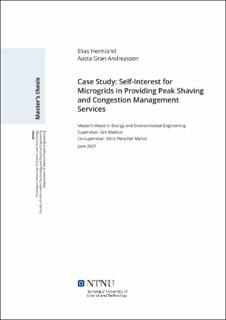| dc.contributor.advisor | Klæboe, Gro | |
| dc.contributor.advisor | Myhre, Stine Fleischer | |
| dc.contributor.author | Heimland, Elias | |
| dc.contributor.author | Andreassen, Aasta Gran | |
| dc.date.accessioned | 2021-10-12T17:21:28Z | |
| dc.date.available | 2021-10-12T17:21:28Z | |
| dc.date.issued | 2021 | |
| dc.identifier | no.ntnu:inspera:79771761:48594350 | |
| dc.identifier.uri | https://hdl.handle.net/11250/2789437 | |
| dc.description.abstract | Det har de siste årene vært en økning i uregulerbar kraftproduksjon og et endret forbruksmønster hos sluttbruker. Analyser av den langsiktige utviklingen i kraftsystemet tilsier at denne utviklingen vil fortsette. Dette fører til at operatører av distribusjonsnett forventer en økning flaskehalsproblematikk. I denne sammenheng peker mange mot at fleksible ressurser er den mest kostnadseffektive løsningen. Fleksible ressurser er definert som systemer med regulerbar kraftproduksjon og/eller -forbruk. Mikronett er et eksempel på dette.
Case-studien i denne oppgaven tar for seg et mikronett og driften av dets fleksible ressurser. Målet med case-studien er å avgjøre om den eksisterende norske markedsmodellen og regelverket medfører en implisitt egeninteresse for markedsaktører i å tilby toppkutting-tjenester. Denne egeninteressen ligger i den økonomiske gevinsten ved å bruke lagringssystemer for krafthandel som utnytter prissvingninger. Oppgaven argumenterer for at en sammenheng mellom strømpriser og flaskehalstendenser i det lokale distribusjonsnettet gjør at krafthandel medfører flaskehalshåndtering. Som grunnlag for studien formuleres flere multi-period optimal power flow problemer. Disse optimeringproblemene kan bidra til å identifisere på hvilke områder målene til en mikronett-eier og operatører av distribusjonsnett sammenfaller.
De kvantitative resultatene fra modellsimuleringen i case-studien antyder at det er økonomiske incentiver for eiere av lagringssystemer til å tilby toppkutting og flaskehalshåndtering i systemer hvor disse er utelukkende motivert av markedsbaserte virkemidler. Resultatene indikerer også hvordan en innføring av nodeprising vil styrke sammenhengen mellom strømpriser og flaskehalstendenser i det lokale distribusjonsnettet sammenlignet med den eksisterende soneprissystem. | |
| dc.description.abstract | Recent years have seen an increase in non-dispatchable energy resources and a changing power consumption pattern. With his trend expected to continue, distribution system operators anticipate a rise of power congestion issues in transmission lines. Many points towards flexible resources being the most cost-efficient solution for addressing this issue. Flexible resources can be regarded as systems with controllable power production and/or consumption. Microgrids are an example of this.
The case study in this thesis regards a microgrid and the operation of its flexible resources. The objective of the case study is to determine if the existing Norwegian market model and regulations facilitates for the self-interest of market players in providing peak shaving and congestion management services. The self-interest lies in the economical gain from utilising storage systems for power trading that exploits price fluctuations. The thesis argues that a correlation between electricity prices and congestion tendencies in the local distribution grid makes power trading implicate congestion management. To prove this, several multi-period optimal power flow problems are formulated. These help in identifying in which areas the objectives of a microgrid owner and the distribution system operator coincide.
The quantitative results from the simulation of the case study model suggest that there are economical incentives for storage system operators to provide peak shaving and congestion management services in a system where they are strictly motivated by market-based drivers. It also indicates how implementing a nodal pricing model, compared to the existing zonal pricing model, would strengthen the correlation between electricity prices and congestion tendencies in the local distribution. | |
| dc.language | eng | |
| dc.publisher | NTNU | |
| dc.title | Case Study: Self-Interest for Microgrids in Providing Peak Shaving and Congestion Management Services | |
| dc.type | Master thesis | |
